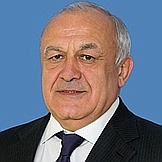Regional flags and emblems


PROFILE
Established 7 July 1924 as North Ossetian Autonomous Region
North Ossetian ASSR since 1936
North Ossetian SSR since 1991
Republic of North Ossetia since 1993
Republic of North Ossetia-Alania since 1996
Capital Vladikavkaz
The Republic of North Ossetia-Alania is part of the North Caucasus Federal District
Area 8,000 sq km
Population 678 500 (2025)
Ethnic groups
(2020 National Census, %)
Ossetian – 68,07
Russian – 18,91
Ingush – 3,76
Kumyk – 2,79
Armenian – 1,81
Georgian – 1,05
Other – 3,61
Administrative divisions (2024)
Municipal districts – 8
City districts – 1
Rural towns – 5
Rural districts – 97
Geography and climate
The Republic of North Ossetia-Alania is located on the northern slope of the Greater Caucasus range and on the adjacent lowlands. The mountain ranges cover about 50% of the republic’s territory with the highest point being Mount Kazbek at 5,033 m.
The republic borders on other Russian regions, including the Republic of Ingushetia, the Kabardino-Balkarian Republic, the Chechen Republic, the Stavropol Territory. It also shares a border with Georgia and the Republic of South Ossetia.
The configuration of its terrain is complex and diversified. The largest terrain elements are flatlands of the Pre-Caucasian region in the north and mountain ranges of the Greater Caucasus in the south. Mountain passes are very high (over 4,000 m) and hard to access.
The climate is temperate continental, but it is characterised by a wide diversity of climatic conditions caused by the varying altitudes in the area. January temperatures average –2.5°C; July temperatures average 23.8°C. The winter is mild, in the mountains it is longer and colder than on the flatlands); the summer is long, but not torrid. Tropical cyclones with heavy showers and thunderstorms are also possible. Other regions with similar climatic conditions include Switzerland, Austria and Italy.
The protected areas of the republic include the North Ossetia Nature Reserve, Alaniya National Park and over 200 natural monuments of the republican significance.
The Republic of North Ossetia-Alania is of great strategic importance due to its favourable geographical location. The territory provides a direct entry into the South Caucasus region across the Greater Caucasus mountain range along the Georgian Military Road, the Transcaucasian Highway.
Government
The legislative branch in the Republic of North Ossetia-Alania is represented by the Parliament of the Republic of North Ossetia-Alania, which is the permanent, representative and only body of state legislative authority in the Republic of North Ossetia-Alania.
The Parliament of the Republic of North Ossetia-Alania consists of 70 deputies running in a single republican electoral district, where winners are identified in proportion to the number of votes cast for lists of deputies nominated by electoral associations.
The current Parliament of the Republic of North Ossetia-Alania was elected in September 2022. Its term expires in September 2027.
Executive power in the Republic of North Ossetia-Alania is exercised by the Head of the Republic of North Ossetia-Alania, the Government of the Republic of North Ossetia-Alania and some other executive authorities.
The Head of the Republic of North Ossetia-Alania is the highest-ranking official in the republic and the head of the republic’s executive branch of government. The Head of the Republic is elected by the Parliament of the Republic of North Ossetia-Alania for five years. The term of office of the current Head of the Republic expires in September 2026.
The Government of the Republic of North Ossetia-Alania is the supreme permanent collegial body of executive authority in the republic. The Prime Minister of the republic is appointed by the Head of the Republic of North Ossetia-Alania with the approval of the republic’s Parliament.
Economy and natural resources
The economy of the Republic of North Ossetia-Alania is represented by a well-developed industry and multifunctional agriculture.
The leading role in industrial production belongs to manufacturing, production and distribution of electricity, gas and water, as well as mining.
Manufacturing is represented by non-ferrous metals (Elektrotsinc, Pobedit), pulp-and-paper, forest, wood processing and food industries, machine building, and metal processing (Magnit, Elektrokontaktor). A number of companies in the region specialise in the production of various electrical equipment. Baspik is the Russian monopolist in the sphere of scientific research, development and production of microchannel plates, and one of the world’s leaders in this sphere. Keton is Russia’s only supplier of ultra-thin capacitor foils.
The region’s electricity, gas and water are produced and distributed by hydroelectric power plants (the North-Ossetian branch of RusHydro), thermal power plants and combined heat and power stations. The largest share in power production belongs to Gizeldon, Dzaudzhikausk, Zaramagsk, and Ezminsk hydro power stations. The republic’s electricity output covers all of its power consumption. Over 90% of the towns and rural localities in the republic have natural gas.
Mineral production is based on proved deposits of polymetallic ores, raw materials for cement production, natural construction materials, mineral waters and therapeutic muds. The potential for the republic’s industrial development lies in its rich mineral deposits, notably the deposits of polymetallic ores, which contain lead, zinc, silver, cadmium and bismuth.
There are four explored oil deposits in the republic (Zamankulskoye, North-Malgobekskoye, Kharbizhinskoye and Akhlovskoye) and several potential oil- and gas-bearing provinces (Korinskaya, South-Kharbizhenskaya, Argudanskaya, Kardzhinskaya and Nartovskaya).
The transport infrastructure comprises railways, motorways (including the Caucasus Federal Motorway) and the aviation sector, with Vladikavkaz Airport servicing local and international flights.
Apart from these main industrial complexes, the following industries are also well-developed in the Republic of North Ossetia-Alania: construction materials industry, wood processing, chemical and light industries, as well as textiles and apparel.
Agriculture accounts for over 10% of the regional GDP and is characterised by the dominance of livestock breeding over crop production due to the landscape and climatic conditions, the traditional industry and the specifics of local consumption.
The main directions in the area of agriculture are in crop production – grain production (wheat, barley, oat, corn), industrial crop production (sunflower, rapeseed, soya), vegetable production, horticulture, forage cultures; in livestock breeding – production of beef, lamb meet, poultry, milk and eggs. Programmes for poultry farming, pig breeding, sheep breeding, and fishing have been developed and adopted.
Culture and tourism
The Republic of North Ossetia-Alania is rightfully considered to be the cultural and ethnographic centre of the North Caucasus. The republic is home to the oldest Vakhtangov Russian Drama Theatre in the North Caucasus, opened in 1871, the North Ossetian State Drama Theatre, the State Opera and Ballet Theatre, along with the State Philharmonic Hall.
The republic’s unique nature and climatic conditions and rich culture and history combine to create great potential for the development of tourism and recreation in the republic.
One of the promising tourism directions is eco-tourism, which is represented by such types of tourist activities as rural tourism, mountain wellness tourism, primary wellness tourism, and local history-oriented tourism.
Primary wellness tourism is well-developed in the region.
There are over 300 balnearies of medicinal and table mineral waters (Lower-Karmadonskoye, Tibskoye, Tamisskoye, Zaramagskoye, Korinskoye, Zamankulskoye, Redantskoye, Razdolnenskoye and Mamisonskoye deposits). The Ossetian mineral waters possess unique properties, chemical and gas composition, and show potential for the development of balneotherapeutic health resorts.
The republic’s richest place in respect of resources and potential is the recreational geographical complex of the Mamison Canyon. Very popular among tourists is the pearl of the Caucasus – the Tsey Canyon. From here you can hike up to the Skazsky Glacier. There is a great ski trail here, an old-growth pine forest, waterfalls, high snowy peaks, glaciers and alpine meadows. The average sunshine hours in Tseya exceed by far the corresponding number in Davos, Switzerland.
One place that will surely leave a lasting impression is the Digor Canyon with its pristine beauty, numerous relics of the past, and its main place of interest – Karaugom Glacier, which is the second largest glacier in the North Caucasus.
The republic has a rich cultural legacy, which is represented in its traditions, material cultural monuments and works of art.


